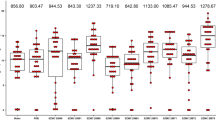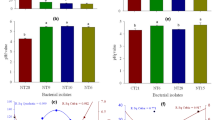Abstract
Two Pb(II)-resistant bacteria isolated from a soil containing 2,500 mg/kg of Pb were identified by 16S rRNA sequencing analysis as Delftia sp. and designated as 3C and 6C. Both isolates grew at a Pb(II) concentration of 62 mg/L and at the stationary phase showed a Pb(II)-sorption capability of 10 ± 1.5 (3C) and 5 ± 0.8 (6C) mg/g of biomass. Biochemical properties related to heavy metal resistance and plant growth promotion were analyzed and compared with the Cr(VI)-resistant plant growth-promoting Delftia sp. JD2, previously reported by our group. Both isolates and JD2 were resistant to Cr(VI), Pb(II) and many antibiotics, produced siderophores and the phytohormone indole-3-acetic, and showed clover growth-promoting activity in greenhouse conditions. Interestingly, the occurrence of integron class 1 was shown in all isolates. Our results add to previous reports and suggest that bacteria of the genus Delftia could be consider as good candidates for the design of technologies for cleaning up contaminated environments and/or the production of biofertilizers.

Similar content being viewed by others
References
Baker-Austin C, Wright MS, Stepanauskas R, McArthur JV (2006) Co-selection of antibiotic and metal resistance. Trends Microbiol 14:176–182
Bazot S, Bois P, Joyeux C, Lebeau T (2007) Mineralization of diuron [3-(3, 4-dichlorophenyl)-1, 1-dimethylure] by co-immobilized Arthrobacter sp. and Delftia acidovornas. Biotechnol Lett 29:749–754
Benndorf D, Babel W (2002) Assimilatory detoxification of herbicides by Delftia acidovorans MC1: induction of two chlorocatechol 1,2-dioxygenases as a response to chemostress. Microbiol 148:2883–2888
Boucher Y, Labbate M, Koening JE, Stokes HW (2007) Integrons: mobilizable platforms that promote genetic diversity in bacteria. Trends Microbiol 15:301–309
Caravaglia L, Cerdeira SB, Vullo DL (2010) Chromium (VI) biotransformation by β- and γ-proteobacteria from natural polluted environments: a combined biological and chemical treatment for industrial wastes. J Haz Mat 175:104–110
CLSI Clinical and Laboratory Standards Institute (2006) Methods for dilution antimicrobial susceptibility tests for bacteria that grow aerobically. Approved standard M7–A7, 7th edn. CLSI, Wayne, PA
Dursun AY, Uslu G, Cuci Y, Aksu Z (2003) Bioaccumulation of copper(II), lead(II) and chromium(VI) by growing Aspergillus niger. Process Biochem 38:1647–1651
Hardwick SA, Stokes HW, Findlay S, Taylor M, Gillings MR (2008) Quantification of class 1 integron abundance in natural environments using real-time quantitative PCR. FEMS Microbiol Lett 278:207–212
Han J, Sun L, Dong X, Cai Z, Sun X, Yang H, Wang Y, Song W (2005) Characterization of a novel plant growth-promoting bacteria strain Delftia tsuruhatensis HR4 both as a diazotroph and a potential biocontrol agent against various plant pathogens. Syst Appl Microbiol 28:66–76
Juárez-Jiménez B, Manzanera M, Rodelas B, Martínez-Toledo MV, Gonzalez-López J, Crognale S, Pesciaroli C, Fenice M (2010) Metabolic characterization of a strain (BM90) of Delftia tsuruhatensis showing highly diversified capacity to degrade low molecular weight phenols. Biodegrad 21:475–489
Khan AG (2005) Role of soil microbes in the rhizospheres of plants growing on trace metal contaminated soils in phytoremediation. J Trace Elem Med Biol 18:355–364
Malik A (2004) Metal bioremediation through growing cells. Environ Inter 30:261–278
Mañay N, Cousillas AZ, Alvarez C, Heller T (2008) Lead contamination in Uruguay: the “La Teja” neighborhood case. In: Whitacre DM (ed) Reviews of environmental contamination and toxicology, vol 195. Springer Press, New York, pp 93–115
Morel MA, Ubalde MC, Braña V, Castro-Sowinski S (2011) Delftia sp. JD2: a potential Cr(VI)-reducing agent with plant growth-promoting activity. Arch Microbiol 193:63–68
Morel MA, Ubalde MC, Olivera-Bravo S, Callejas C, Gill PR, Castro-Sowinski S (2009) Cellular and biochemical response to Cr(VI) in Stenotrophomonas sp. FEMS Microbiol Lett 291:162–168
Müller RH, Babel W (2004) Delftia acidovorans MC1 resists high herbicide concentrations—a study of nutristat growth on (RS)-2-(2,4-dichlorophenoxy) propionate and 2,4-dichlorophenoxyacetate. Biosci Biotechnol Biochem 68:622–630
Patil NK, Kundapur R, Shouche YS, Karegoudar TB (2006) Degradation of plasticizer di-n-butylphathalate by Delftia sp. TBKNP-05. Curr Microbiol 52:369–374
Prakash D, Pandey J, Tiwary BN, Jain R (2010) Physiological adaptations and tolerance towards higher concentration of selenite (Se+4) in Enterobacter sp. AR-4, Bacillus sp. AR-6 and Delftia tsuruhatensis Ar-7. Extremophiles 14:261–272
Rosewarne CP, Pettigrove V, Stokes HW, Parsons Y (2010) Class 1 integrons in benthic bacterial communities: abundance, association with Tn402-like transposition modules and evidence for coselection with heavy-metal resistance. FEMS Microbiol Ecol 72:35–46
Singh S, Goyal D (2007) Microbial and plant derived biomass for removal of heavy metals from wastewater. Biores Technol 98:2243–2257
Spaepen S, Vanderleyden J, Remans R (2007) Indole-3-acetic acid in microbial and microorganism-plant signaling. FEMS Microbiol Rev 31:425–448
Stokes HW, Nesbø CL, Holley M, Bahl MI, Gillings MR, Boucher Y (2006) Class I integron potentially predating the association with Tn402-like transposition genes are present in a sediment microbial community. J Bacteriol 188:5722–5730
Wen A, Fegan M, Hayward C, Chakraborty S, Sly LI (1999) Phylogenetic relationship among members of the Comamonadaceae, and description of Delftia acidovorans (den Dooren de Jong 1926 and Tamaoka et al. 1987) gen. nov., comb. nov. Int J Sys Bacteriol 49:567–576
Whiting SN, de Souza MP, Terry N (2001) Rhizosphere bacteria mobilize Zn for hyperaccumulation by Thlaspi caerulescens. Environ Sci Technol 35:3144–3150
Xu HX, Davies J, Miao V (2007) Molecular characterization of class 3 integrons from Delftia spp. J Bacteriol 189:6276–6283
Zolgharnein H, Karami K, Mazaheri Assadi M, Dadolahi Sohrab A (2010) Investigation of heavy metals biosorption on Pseudomonas aeruginosa strain MCCB 102 isolated from Persian Gulf. Asian J Biotech 2:99–109
Acknowledgments
We thank Programa de Desarrollo de las Ciencias Básicas (PEDECIBA-Uruguay) for partial financial support. The work of V. Braña, M. Morel, and C. Martinez were supported by Agencia Nacional de Investigación e Innovación (ANII).
Author information
Authors and Affiliations
Corresponding author
Additional information
M.C. Ubalde and V. Braña have contributed equally to this study.
Rights and permissions
About this article
Cite this article
Ubalde, M.C., Braña, V., Sueiro, F. et al. The Versatility of Delftia sp. Isolates as Tools for Bioremediation and Biofertilization Technologies. Curr Microbiol 64, 597–603 (2012). https://doi.org/10.1007/s00284-012-0108-5
Received:
Accepted:
Published:
Issue Date:
DOI: https://doi.org/10.1007/s00284-012-0108-5




